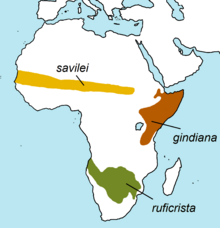Saviletrappe
| Saviletrappe | ||||||||||
|---|---|---|---|---|---|---|---|---|---|---|
| Systematics | ||||||||||
|
||||||||||
| Scientific name | ||||||||||
| Lophotis savilei | ||||||||||
| Lynes , 1920 |
The saviletrappe ( Lophotis savilei ) is a little researched bird of the bustard family . At times it was regarded as a subspecies of the red-headed bustard ( Lophotis ruficrista ). Some taxonomists place them in the genus Eupodotis .
features
The Saviletrappe reaches a size of 42 centimeters. No information is available on weight. It is smaller than the Oustalet bustard ( Lophotis gindiana ) and the redhead bustard . The head is less gray than that of the red-headed bustard. The throat is blacker and the breast is less white than that of the Oustalettrappe. The upper side is more reddish-sand-colored and the tan-colored V-markings of the redhead bustard are almost non-existent on the Saviletrappe. The head and neck of the female have a tinge of cinnamon.
Occurrence

The distribution area of the red-headed bustard stretches across southern Africa in a strip. It extends from southern Angola and north-east Namibia in the west through Botswana, south-west Zambia and Zimbabwe east to Mozambique, and into northern South Africa and Swaziland. The distribution area of the Saviletrappe extends from southwestern Mauritania through Senegal , Mali , Burkina Faso , the Ivory Coast , Niger , northeastern Nigeria to Chad and central Sudan .
habitat
The Saviletrappe inhabits shrubbery and light woodland, thickets next to dried out ponds, clearings and flat scrubland dominated by grasses of the Aristida genus and acacias .
Way of life
No information is available about the behavior of the Saviletrappe when foraging for food. Presumably it is similar to that of the redheaded bustard. In the western part of the range, the breeding season is from September to October. In Chad, breeding activity was observed during the wet season from June to August, and in Sudan, birds in readiness for breeding were observed between July and September. The nesting behavior is evidently similar to the red-headed bustard. The Saviletrappe is usually true to its location, but is a visitor to the W National Park in Niger during the dry season (from December to May) . During the rains, it breeds north outside Nigeria.
status
Little information is available about the population status. The Saviletrappe is said to be quite common in the entire distribution area. In Nigeria it is not common and there it is restricted to the north-west of the country. It is listed in Appendix II of the Washington Convention on Endangered Species and classified by BirdLife International in the “ Least Concern” category.
Individual evidence
literature
- Josep del Hoyo , Andrew Elliot, Jordi Sargatal: Handbook of the Birds of the World. Volume 3: Hoatzin to Auks. Lynx Edicions, Barcelona 1996, ISBN 8487334202 .